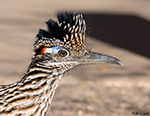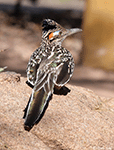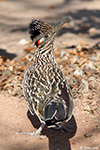| Length: 20-24 inches | Wingspan: 18-24 inches | Seasonality: Non-resident in South Dakota |
| ID Keys: Distinctive appearance and habits, with large size, long tail, brown and streaked overall | ||
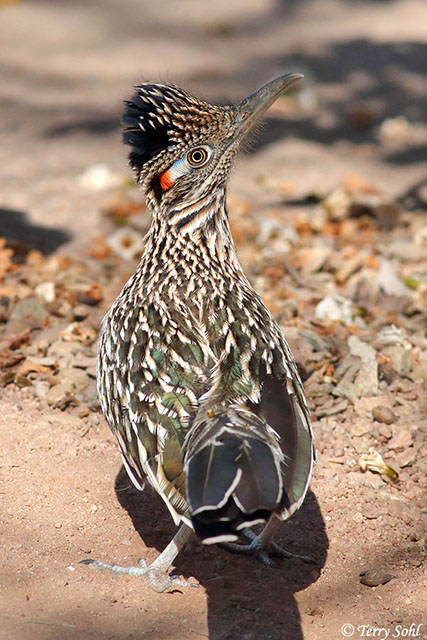 The
Greater Roadrunner is a unique bird most commonly found in the dry Sonoran
desert habitat of the American Southwest, but with a range that extends
eastward to Louisiana and Arkansas. They are unique in appearance and
in behavior. They are large birds with long tails that double their
total length. They are most commonly seen walking or running along the
ground as they forage for food, and will only take flight if threatened or
disturbed. They are the largest member of the North American cuckoo
family.
The
Greater Roadrunner is a unique bird most commonly found in the dry Sonoran
desert habitat of the American Southwest, but with a range that extends
eastward to Louisiana and Arkansas. They are unique in appearance and
in behavior. They are large birds with long tails that double their
total length. They are most commonly seen walking or running along the
ground as they forage for food, and will only take flight if threatened or
disturbed. They are the largest member of the North American cuckoo
family.
Habitat:
Found in a variety of brushy habitats, but is the most common in Sonoran desert habitats with scattered scrubs and cactus. They are much less commonly found in grassland or woodland edges.
Diet:
Omnivorous, feeding on a wide variety of items. Mostly feeds on animals, including large insects, lizards, snakes, small rodents, small birds, eggs, scorpions, and large spiders like tarantulas. They will also eat fruits and berries, sometimes feeding heavily on cactus fruits in season in appropriate habitats. Seeds and nuts are also sometimes eaten if available.
Behavior:
Hunts by rapidly walking along the ground, dashing after prey when spotted.
Nesting:
The Greater Roadrunner is thought to possibly mate for life, as nesting pairs will defend a territory at all times of the year. The nest is a platform of sticks, lined with softer vegetative material and feathers, placed between 2 and 10 feet from the ground in a bush, cactus, or small tree. Both the male and female help to incubate the eggs, and both parents help to feed and tend to the young after they hatch.
Song:
The song of a Greater Roadrunner is a slow series of cooing notes that descend and become less intense towards the end. They also make rattling sound with their bills.
Migration:
Considered a permanent resident throughout its range. Young birds may disperse moderate distances once fledged and independent.
Interactive eBird Map:
Click here to access an interactive eBird map of Greater Roadrunner sightings
Similar Species:
Distinctive, not likely to be confused with another species in range. For additional identification clues, look for a trailing coyote, trying to capture a Greater Roadrunner, or perhaps trying to drop a safe on its head from a high cliff top. :-)
Feeders:
Will sometimes come to feeders for offered fruit or seeds.
Conservation Status:
The Greater Roadrunner is found over a large geographic range, has a large population, and population trends appear to be stable. The IUCN lists the Greater Roadrunner as a species of "Least Concern".
Further Information:
- California Partners in Flight - Greater Roadrunner
- Arizona Sonoran Desert Museum - Greater Roadrunner
- USGS Bird InfoCenter - Greater Roadrunner
Photo Information: Photo taken at the Phoenix Botanical Gardens on December 28th, 2018 - Terry Sohl
| Click below for a higher-resolution map |
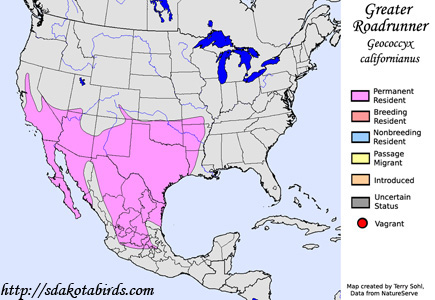 |
| South Dakota Status: Non-resident in South Dakota |
Additional Greater Roadrunner Photos

